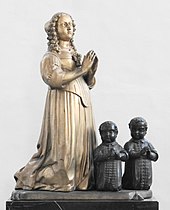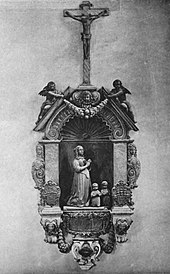Sophie Hedwig of Schleswig-Holstein-Sonderburg-Glücksburg
Sophie Hedwig (also Sophia Hedwig ; * October 7, 1630 in Glücksburg , Holstein ; † September 27, 1652 in Dresden , Saxony ) was a princess from the older line of Schleswig-Holstein-Sonderburg-Glücksburg of the House of Oldenburg . By marriage in 1650 she became a daughter-in-law of the reigning Saxon Elector Johann Georg I and was designated Duchess of Saxony-Zeitz .
Life
Sophie Hedwig was the second daughter and sixth child of Duke Philipp , who resided at Schloss Glücksburg , and his wife Sophie Hedwig of Saxony-Lauenburg (1601–1660), a daughter of Duke Franz II of Saxony-Lauenburg . Her father was the founder of the older Schleswig-Holstein-Sonderburg-Glücksburg line , but as a separate lord was not a ruling duke.
Like her younger sister Christiana , the princess may have lived for some time with the childless Danish Crown Princess Magdalena Sibylla of Saxony at Nykøbing Castle ( Nykøbing on Falster ). The Crown Princess, who was widowed and thus no longer queen in 1647, was a daughter of the Saxon Elector Johann Georg I. Sophie Hedwig seems to have been educated later with the widowed Brunswick Duchess Anna Sophia of Brandenburg at Schöningen Palace, or at least she became their wedding accompanied by the Duchess's court master.
At the end of the Thirty Years' War , the Saxon Elector Johann Georg I endeavored to also marry his last two unmarried sons. While his wife Magdalena Sibylle von Prussia abstained from choosing a partner for the children, but took care of the wedding arrangements in particular for the daughters, it was his widowed sister-in-law Hedwig of Denmark who referred Sophie Hedwig to Prince Moritz . His older brother Christian took the initiative and courted Sophie Hedwig's sister Christiana. On November 19, 1650, 35-year-old Christian and 16-year-old Christina and 31-year-old Moritz married 20-year-old Sophie Hedwig in a double wedding at Dresden Palace . The sermon delivered at the same time was printed by Oberhof preacher Jakob Weller . The celebrations of this double wedding extended over four weeks with tournaments, hunts, numerous court ballets , theater performances and the presentation of the Argonauts saga as fireworks. In the reports of the wedding, the excess and the extraordinary, such as the drinking bouts, hunts and fireworks, have a significantly higher priority than the performing arts.
From their marriage there were two sons, both of whom died in infancy:
- Johann Philipp (born November 12, 1651; † March 23, 1652; 19 weeks old)
- Moritz (born September 26, 1652; † May 10, 1653; 32 weeks old)
Ten days before her 22nd birthday, she died in childbed the day after the birth of her second son in Dresden. Her burial in the crypt of the Sophienkirche took place three months later, on December 27, 1652, with princely pomp. The funeral sermon given by Oberhofprediger Jakob Weller, like that for the two sons, was put to the press again.
While the elector had already in July 1652 and therefore the lifetime Sophie Hedwig in a will setting up Sekundogeniturfürstentümern has for his three youngest sons, the reaction was carried out but only after his death in 1656. This is Sophie Hedwig no longer Duchess of Saxony-Zeitz become .
epitaph
The sculptor Wolf Ernst Brohn , from whom Sophie Hedwig's coffin came, created the epitaph of the Duchess, which is considered to be his main work. Since 1653 it had been on the north wall of the choir of the Dresden Sophienkirche with bronze figures cast by Andreas Herold based on Brohn's models. In the center of the figure, the kneeling Sophie Hedwig and her two sons were folded with their hands in prayer.
During the Second World War, the bronze parts were moved to the basement of the Frauenkirche in 1943 . The bronze figure of Sophia came to Freiberg Cathedral in 1975 , where the Duchess's coffin and others had been transferred from the princely crypt of the Sophia Church, which was badly damaged in the war, in 1950. The figures of the two princes stolen from Dresden in the 1950s were found in Bavaria (Moritz) and Schleswig-Holstein (Johann Philipp). The group of figures in Freiberg has been reunited in the cathedral choir since 2002. Other parts of the epitaph can be found in various places in Dresden, including the inscription plaque in the State Office for the Preservation of Monuments , the bronze angels in the Matthäuskirche and the bronze crucifix in the Heinrich Schütz Chapel of the Kreuzkirche .
Footnotes
- ↑ a b Ute Essegern : Princesses at the Electoral Saxon Court: Concepts of life and life courses between family, court and politics in the first half of the 17th century (= writings on Saxon history and folklore . Volume 19 ). Leipziger Universitätsverlag, 2007, ISBN 978-3-86583-074-6 , ISSN 1439-782X , p. 383 ( limited preview in Google Book Search - by evaluating the Heiratsacta Mr Christian and Mr Moritz 'to Saxony with two princely Holstein Miss , inventory 10024, Loc 10559/11. , Central State Archive Dresden ).
-
↑ The day of death corresponds to the information on the brass tablet of the epitaph. Deviating from this, Zedler says October 27th, that would be a month after the birth of the second son: Zeitz . In: Johann Heinrich Zedler (Hrsg.): Large complete universal lexicon of all sciences and arts . tape 61 . Leipzig and Halle 1749, p. 937 ( digitized in the Google book search). Completely incorrect dating of death to the year 1660 can be traced back to confusion with her mother Sophie Hedwig von Sachsen-Lauenburg .
- ↑ a b Benjamin Gottfried Weinart : Topographical history of the city of Dresden, and the areas around it . Hilschersche Buchhandlung, Dresden 1777, p. 178 f . ( Digitized in the Google book search - the daughter Eleonora Magdalena mentioned there came from Moritz's second marriage.).
- ↑ Ute Essegern : Princesses at the Electoral Saxon Court: Concepts of life and life courses between family, court and politics in the first half of the 17th century (= writings on Saxon history and folklore . Volume 19 ). Leipziger Universitätsverlag, 2007, ISBN 978-3-86583-074-6 , ISSN 1439-782X , p. 411 ( limited preview in Google Book search).
- ↑ Ute Essegern : Princesses at the Electoral Saxon Court: Concepts of life and life courses between family, court and politics in the first half of the 17th century (= writings on Saxon history and folklore . Volume 19 ). Leipziger Universitätsverlag, 2007, ISBN 978-3-86583-074-6 , ISSN 1439-782X , p. 325 ( limited preview in Google Book Search).
- ↑ Jacob Weller : Chur-Sächsischer Rauten-Stock und Gottes Paradiess / That is: A Christian wedding sermon and sermon / Held at the Princely Beylager / Who ... Princes ... Mr. Christiani / And Mr. Moritzen / Brothers / Drawn to Saxony / Jülich, Cleve and Berg… And those too… Princesses… Miss Christianen / and Miss Sophien Hedwig / Siblings / Hertzoginnen zu Schleßwig / Holstein… On November 19th and 20th of the 1650th year on the Churf. Castle at Dreßden. Dresden 1650 ( online )
- ↑ Eberhard Fähler: Fireworks of the Baroque. Studies on the public festival and its literary interpretation from the 16th to 18th centuries . Metzler, Stuttgart 1974, ISBN 3-476-00276-4 , p. 112 ff ., Doi : 10.1007 / 978-3-476-03026-9 ( limited preview in the Google book search).
- ↑ Elisabeth Rothmund : Heinrich Schütz (1585–1672): Cultural patriotism and German secular vocal music: "To take up the music / also increase our nation's fame" (= Collection Contacts: Etudes et documents . Volume 63 ). Peter Lang, 2004, ISBN 3-03910-042-4 , ISSN 0933-6095 , p. 247 ( limited preview in Google Book search).
- ^ A b Johann Sebastian Müller: The Chur and Princely House of Saxony, Ernestin and Albertine Lines Annales, from Anno 1400 to 1700 . Johann Ludwig Gleditsch, Leipzig 1701, p. Tabula XXII ( digitized in the Google book search).
- ↑ Jacob Weller: Divine Fire Wall / That is / God devoted souls glorious and mighty protection from the 31st Psalm My time is in your hands: Auffgerierter Since the… Sophien Hedwig / Hertzogin zu Sachsen… Christ's mildest memory Princely corpse In the princely bed in the Sophien-Kirchen zu Dreßden ... was adopted / December 27th. Anno 1652. Dresden, 1653 ( online )
- ^ Walter Hentschel : Dresden sculptors of the 16th and 17th centuries . Böhlau, 1966, p. 93, 157 (also in this: Monuments of Saxon Art: The Losses of the Second World War , Akademie-Verlag, 1973, p. 59.).
- ↑ a b Epitaph of Hedwig Sophie should be completed. In: Freie Presse , February 6, 2002 ( online ).
| personal data | |
|---|---|
| SURNAME | Schleswig-Holstein-Sonderburg-Glücksburg, Sophie Hedwig von |
| ALTERNATIVE NAMES | Schleswig-Holstein-Sonderburg-Glücksburg, Sophia Hedwig von |
| BRIEF DESCRIPTION | Holstein princess, designated Duchess of Saxony-Zeitz |
| DATE OF BIRTH | October 7, 1630 |
| PLACE OF BIRTH | Glücksburg , Holstein |
| DATE OF DEATH | September 27, 1652 |
| Place of death | Dresden , Saxony |

